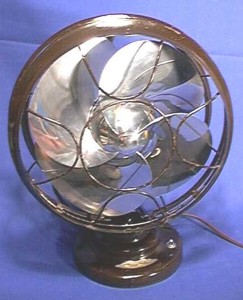A Brief History of Fans
The earliest electric fans appeared in the
early 1880’s. The fan was basically a blade attached to an electric motor. The
development of the fields of Electrical Engineering and
Aeronautical Engineering paralleled each other in the industry of electric fans.
The early
electric motors were bipolar. They were direct current, with all exposed
workings. The early blades were adapted from the windmill, with usually six pie
shaped flat leafs of brass. Speed control was attained using resistance. In
almost all cases resistance wire was used, and in a few cases, the light bulb
was used a resistance. These early fans were either a novelty, or an expensive
appliance, used in large offices or wealthy homes.
After Tesla’s work on Alternating Current motors, most
makers moved toward that standard. In the early 1890’s, motors were becoming
enclosed. Fan cages appeared. The cage was not there to protect the user, as
much as to protect the expensive fan and blade from damage. The blade designs
remained six wings. The Alternating Current motor was controlled using
induction, rather than resistance.
Around 1900, blade designs began to change, along with
increased competition. The earliest oscillating fans began to appear. First they
were wind driven, and by 1904 the first mechanical oscillating fan appeared. By
1906, all electric motor theory was done. The only improvement on motor design
would come in the 1930’s. The biggest improvement in motors was improved
insulation for copper wires used to wind motors. Until the early 1890’s, these
wires were wrapped with silk, and later cotton covered wire as insulation. An enamel
insulation improved, smaller wires could be used, and thus smaller motors made.
By 1910, most fan makers were using rounded edge
blades, if not designs they had patented themselves. All major manufacturers
were making some form or wind driven, or mechanical oscillator. Motors were all
enclosed by now as well as smaller in size.
The decade of 1910-1920 brought major
changes. Around 1910, electric fans were being made for residential use. These
“Residential Fans” were made for the bedroom. They had six wings, and ran at a
slower speed for quietness. Fans were still a major appliance. By 1912, makers
were able to “spin” brass housings on small fans. Shortly afterward, they could
“spin” or stamp steel for motors as well as bases. As World War 1 neared, there
were brass shortages, due to the need for brass in ammunition. By the end of
this decade, brass cages had been replaced by steel cages. All blades were now
rounded in shape. Motors shrank from 8” diameter down to 5”. Almost all makers
used black as their color on the fan bodies, but General Electric went to a deep
green color.
By 1920, refrigerated air was appearing in commercial
buildings. Fan makers began to market fans more towards residential use, as the
new refrigerated displaced their commercial markets. Makers began experimenting
with design changes. Two competitors introduced fans designed as radio speakers,
in a brown wood-grain finish. Late that decade, General Electric introduced the
overlapping blade, which operated much more quietly. These early blades also
were made of aluminum, rather than steel. Aluminum was being used more now in
manufacturing.

Early in 1930, a young woman named Jane Evans came to
St. Louis to do some interior design work. She was introduced to the President
of Emerson Electric. She proposed a radical stylish design. In 1932 Emerson
introduced the Silver Swan. It used a blade made of aluminum, but was based on a
yacht propeller design. The design was a major success, and probably helped
Emerson survive the Depression. More and more aluminum was used for blades and
designs varied greatly. Many colors were offered including Ivory, Forest Green,
Dark Brown, Chrome, Nickel, Motors received their last important change. Emerson
introduced the capacitor start motor. These started faster, ran quieter and were
much more efficient. Motors were now as small as 4” in diameter and could propel
a 16” blade made of aluminum. Cast aluminum blades appeared, using the latest
aeronautical designs.
In the 1940’s we were a Nation at war. Fan makers used
their capacity to help with the war effort. Few if any electric fans were made
for the market. There were no design changes. Production restarted after war
ended, with the same designs as pre-war.
By 1950, air conditioning was becoming available for
homes. A few makers offered fans for homes with wooden cases, to blend with the
televisions. The introduction of residential refrigerated air, was the onset of
decline for the table fan. During the decade of the 1950’s, not much changed in
fans. Cost cutting took over design as a selling point. Cheaper fans were made.
Some used nylon for gears, versus brass or steel. Colors introduced were Grey,
Aqua, Turquoise, as well as wrinkled finishes in paint.
By the 1960’s, most
makers began to phase out their fan lines. By the late 1960’s, the last of the
good fans were being made.
Information Provided by
Steve Cunningham |